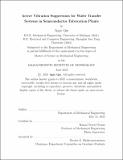Active Vibration Suppression for Wafer Transfer Systems in Semiconductor Fabrication Plants
Author(s)
Qiu, Jiajie
DownloadThesis PDF (17.27Mb)
Advisor
Youcef-Toumi, Kamal
Terms of use
Metadata
Show full item recordAbstract
Vibration suppression is critical in precision mechatronic systems for nanofabrication. In semiconductor plants, automated wafer handling is performed by Overhead Hoist Transport (OHT) vehicles that transport wafers in front opening unified pods (FOUPs). When the wafers are transported in FOUPs, semiconductor chips are at risk of damage by excited small particles due to mechanical vibration, especially if such particles land on the critical area of the wafers. To minimize the vibration excitation force transferred to the FOUP, this thesis focuses on active suppression of the FOUP vibrations to improve the production yield. However, two primary challenges make this problem difficult. First, the OHT vehicle and the FOUP keep traveling, thus the target system is floating with no external anchoring point as a momentum source for control efforts. Second, no sensor attachment is permitted on mass-production FOUPs, which makes feedback control more challenging without measurement. To address the challenges and achieve the goal of reducing FOUP acceleration peaks, an inertia-based counterbalancing system is developed. To validate this system, a customized testbed is built to replicate the acceleration profile of the OHT vehicle in both travel and lateral axes. Additionally, an active vibration suppression system is designed to generate a controllable force on the hand unit. System modeling and identification are conducted using simulation and experiment to identify the system dynamics. Finally, a Disturbance Observer-Based Controller (DOBC) is developed and implemented on the hardware. The experimental results show that the DOBC achieves 38 percent reduction of OHT hand unit vibration and 42 percent reduction of FOUP vibration in the OHT travel direction. Furthermore, the proposed method successfully reduces the multi-axis FOUP-level acceleration peaks, further confirming the effectiveness of the proposed method.
Date issued
2023-06Department
Massachusetts Institute of Technology. Department of Mechanical EngineeringPublisher
Massachusetts Institute of Technology